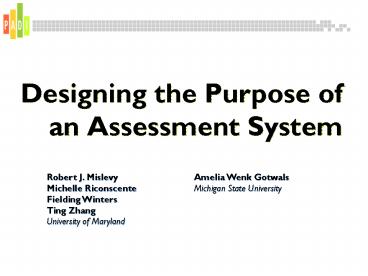Designing the Purpose of an Assessment System PowerPoint PPT Presentation
1 / 32
Title: Designing the Purpose of an Assessment System
1
Designing the Purpose of an Assessment System
Robert J. Mislevy Michelle Riconscente Fielding
Winters Ting Zhang University of Maryland
Amelia Wenk Gotwals Michigan State University
2
The Why of PADI
- Advanced assessment requires coordination of
varied expertise - Assessment design is both science and art
- Capitalize on schemas for recurring structures,
patterns, relationships - Explicit validity arguments
- Accumulated wisdom sharablenot context bound
- Interoperability of elements processes (esp.
technological settings)
3
Session Overview
- Some Thinking Tools
- Assessment as Argument
- A Layered Approach
- Design Patterns / Domain Specifications
- Present
- Hands-on Browse
- Templates
- Present
- Hands-on Browse
- Coming up
- Hands-on Create
4
Law as Argument
C
unless
A
since
W
on account of
supports
so
R
B
D
Toulmin (1958)
5
Assessment as Argument
Inferences
C
- Inferences
- Observations needed to ground them
- Situations that will evoke them
- Chain of reasoning connecting them
since
since
W
Observations
D
Situations
6
A Layered Approach
- Leverage varied expertise
- Common structures
- Well use layers to
- iterate through the assessment argument,
- using different knowledge representations,
- moving from knowledge about the domain to the
nuts and bolts of assessment design and delivery.
7
Evidence-Centered Design Layers
- Thinking about e.g., science learning inquiry
Domain Analysis
Express content as an assessment argument
Domain Modeling
Conceptual Assessment Framework
- Technical elements of assessment design
delivery
Assessment Implementation
Assessment Delivery
8
Design Patterns / Domain Specs
- PADI uses Design Patterns (aka Domain
Specifications) to organize information in the
Domain Modeling layer - Narrative, not technical, contents
- The Design Pattern schema reflects assessment
argument structure
- Express content as an assessment argument
Domain Modeling
9
We Live in a World of Patterns
10
Definition of Patterns
Patterns help to establish the rules or
guidelines for what something does or looks like.
A group of patterns on a similar topic is like a
recipe book.
11
Analogues
- Design Patterns in Architecture
- Design Patterns in Software Engineering
- Poltis Thirty-Six Dramatic
- Situations
12
PADI Design Patterns
- Identify in narrative form
- STUDENT MODEL Knowledge, skills, and abilities
- Observations to support inference
- Features of task situations that elicit target
KSAs - Related content or inquiry standards
- Do not provide a concrete design or
implementation of an assessment task
13
(No Transcript)
14
Design Pattern Benefits
- Facilitate decision-making
- Explicate the assessment argument
- Afford flexibility
- Psychological perspectives
- Generality
- Interdependence (i.e., related patterns)
- Scale
15
Browsing PADI Design Patterns
- For starters
- BioKIDS Kids Inquiry of Diverse Species
16
BioKIDS Purpose Population
- Sequence of inquiry-based science curricula
- Systematically follow students over time
- Detroit Public Schools
- 95 Minority
- 70 Free/reduced lunch
17
BioKIDS Areas of Interest
- Main content areas Biodiversity, weather, simple
machines - Main inquiry reasoning areas scientific
explanations, interpreting data, creating
hypotheses and predictions
18
Browsing PADI Design Patterns
- For starters
- BioKIDS
- Formulating scientific explanations from evidence
(91)
19
Mid-Flight Check
- So far so good?
20
(Back to) ECD Layers
- Thinking about science learning
- inquiry
Domain Analysis
- Express content as an assessment argument
Domain Modeling
Conceptual Assessment Framework
- Technical elements of assessment design
delivery
Assessment Implementation
Assessment Delivery
21
PADI Task Templates
- Support the specification of technical details
- Serve as pre-blueprints abstractions of multiple
assessment tasks - Become task specifications when all template
components are specified
Conceptual Assessment Framework
- Technical elements of assessment design
delivery
Assessment Implementation
Assessment Delivery
22
Domain Modeling
23
Domain Modeling
Conceptual Assessment Framework
TEMPLATE
24
Domain Modeling
Conceptual Assessment Framework
TEMPLATE
Student Model
SM Vars
25
Domain Modeling
Conceptual Assessment Framework
TEMPLATE
Activity
Student Model
SM Vars
26
Domain Modeling
Conceptual Assessment Framework
TEMPLATE
Activity
Student Model
SM Vars
Work Products
Materials Presentation
27
Domain Modeling
Conceptual Assessment Framework
TEMPLATE
Activity
Student Model
Evaluation Procedures
Measurement Models
SM Vars
Obs Vars
Work Products
Evaluation Phases
Materials Presentation
28
Domain Modeling
Conceptual Assessment Framework
TEMPLATE
Activity
Student Model
Evaluation Procedures
Measurement Models
SM Vars
Obs Vars
Work Products
Evaluation Phases
Materials Presentation
Task Model Variables DASHED RED LINE
RUNTIME
TMV
TMV
29
Domain Modeling
Conceptual Assessment Framework
TEMPLATE
Activity
Student Model
Evaluation Procedures
Measurement Models
SM Vars
Obs Vars
Work Products
Evaluation Phases
Materials Presentation
Task Model Variables DASHED RED LINE
RUNTIME
TMV
TMV
30
Domain Modeling
Conceptual Assessment Framework
TEMPLATE
Student Model
SM Vars
Lets browse student models in the PADI Design
System
31
Browsing PADI Templates
- For starters
- BioKIDS
- BioKIDS Main Template (2497)
32
Activity 1 Defining the Assessment Purpose
- Look at existing domain specifications (design
patterns) as examples, using PADI database - Fill out Domain Specification Design Form and
questions 1-4 on Assessment Template Design Form
(both in your activity packet) for an assessment
of your choice - Use the PADI assessment designer to create a new
template for your chosen assessment - Create Domain Specification object (Design
pattern) - Define Student Model(s)
- Define Student Model Variable(s)

